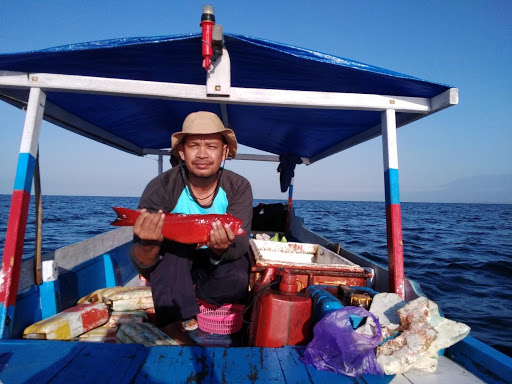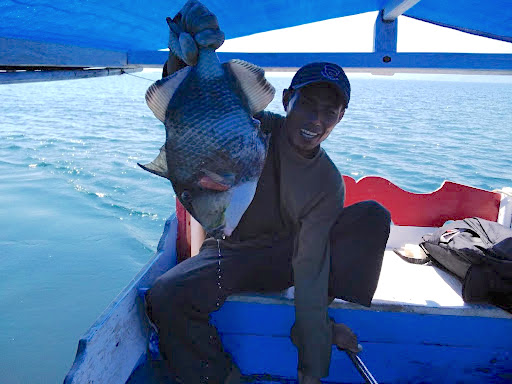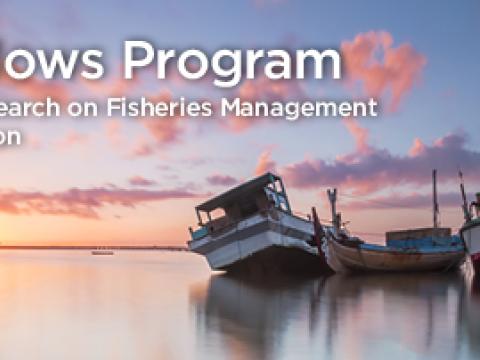MFP Stories from the field: A Fishing Trip to Labuhan Jambu Village in Saleh Bay
Fellow: Diding Sudira Efendi
MFP Project Title: Policy impact assessment on grouper and snapper fisheries supply chain and small-scale fisheries economic in Saleh Bay: An agent-based modeling approach
Successful fisheries management depends on human behavior, which can be observed all along the fishery value chain, from the producer to the consumer. My research focuses on the behavior of fishers during their daily routine fishing trips. Collecting data for this project led us on an adventure that helped us better understand the dynamics of the grouper fishery and the activities of small-scale fishers who depend on the Saleh Bay fisheries for their livelihoods.
This story begins in Labuhan Jambu village, which is one of the largest grouper landing sites in Saleh Bay, especially for coral trout fish (Plectropomus spp. or ikan sunu in Indonesian). Most of the grouper fishers in this village are small-scale, bringing in under 5 gross tons (GT) per year, and use drop line fishing gear known locally as tomba. According to the fishers, the sunu fish population has declined by more than half compared to five years ago. Today, one fishing trip using a drop line only yields 2-5 fish, whereas a few years ago, fishers could catch dozens of sunu fish per day with the same gear. Coral trout are relatively valuable and local fishers must catch at least one per trip to cover their operational costs, which are around IDR 100,000 (US$ 7) for fuel, ice, food, and other expenditures.

Our journey to observe the sunu fish decline in Saleh Bay began on November 18, when we joined a fishing trip with Pak Munawir. At exactly 4:30 in the morning, Pak Nawir started the inboard engine on his boat, the Putra Kelana and went to collect the live bait he had stored in a small basket. Fishers in this area usually use a small fish known as budong-budong as live bait and collect the next day’s baitfish before returning home at the end of the day.
We traveled on Pak Munawir’s wooden boat at 17 km per hour to reach the first fishing location. After almost an hour on the water, our boat stopped about 4 km from the shoreline of the Kolokalo Village-Dompu Regency. Pak Munawir’s knowledge of finding a fishing spot was amazing! He uses a global positioning system (GPS) locator in a dry bag draped over his shoulder to detect his favorite fishing spot. Once certain of a rocky bottom below, he deployed his tomba one by one, until he had as many as 30 hooks in the water at a depth of 30 to 50 meters, while shouting, "Makan semua ki!” meaning “Eat them all, fish!” After about 30 minutes, a sunu fish took the bait and Pak Munawir managed to lift it into the boat. Not long afterward, a second fish devoured the bait and was caught. Pak Munawir kept the live fish in a styrofoam box with the bait to keep them alive and prevent mortality.
A 6:45 a.m. we moved to a second fishing spot and an hour later, a third sunu fish was pulled aboard. Then at 9:00 a.m. Pak Munawir successfully caught a triggerfish, known locally as pogo. The pogo is a non-target species in dropline fishing, which meant it was a bonus fish for Pak Munawir’s family.

Our final fishing location was at the end of the Takat Tebampang, a spot of shallow coral reefs. While waiting for the target fish to bite, we explored the reef by snorkeling, and unfortunately found it mostly damaged due to destructive fishing practices. At 11:40 a.m., we caught a jenaha fish, which is one of the snapper species. After this last fish, we decided to finish for the day and collected baitfish around Rakit Island for the next trip. To fish budong-budong, Pak Nawir used a hand line with the smaller hook than the tomba.
At 2.30 PM, we went back to Labuhan Jambu. On our way, I saw a smile on Pak Nawir’s face, a sign that he was satisfied with the result of the day’s fishing. On this trip, he caught 3 sunu fish (2 alive and 1 dead), 1 pogo fish, and 1 jenaha fish. The live sunu fish, with an average weight of 6-7 ounces, was sold to a floating-cage fish farmer near the Bakau island and then transported to Bali for export. The dead sunu fish was sold by Pak Munawir's wife to a collector in Labuhan Jambu village. In total, Pak Munawir managed to earn around IDR 800,000 (US$ 60) from his catch. Pak Nawir graciously gave us the jenaha fish as a reward for accompanying him at sea, and we ate it the next day.
This trip has given us invaluable first-hand experience in the grouper and snapper fisheries, and the insights we gained from this trip will inform our analysis. I am now even more motivated to help improve the small-scale fisheries in Saleh Bay so they provide sustainable livelihoods for local fishers.
The Marine Fellowship Program is implemented in partnership with the Faculty of Fisheries and Marine Sciences of Bogor Agriculture University (FPIK-IPB) and is made possible with generous support from the David and Lucile Packard Foundation.

